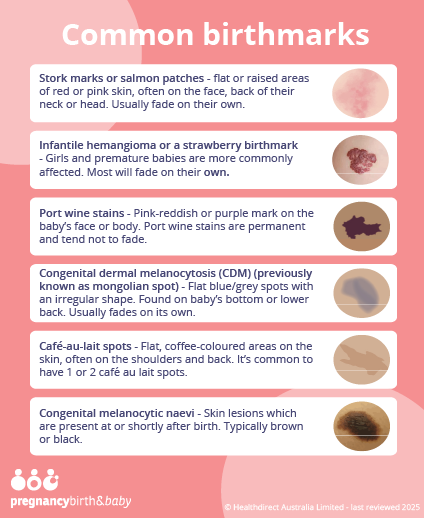Birthmarks
6-minute read
Key facts
- A birthmark is a mark on your child's skin that is present at birth or develops shortly after.
- Birthmarks can be anywhere on the face or body and vary in shape, colour and size.
- Doctors usually diagnose birthmarks by examining your child.
- Most birthmarks are harmless and do not need treatment.
- If a birthmark is large or may cause problems, treatment may be suggested.
What is a birthmark?
A birthmark is any mark on the skin that is present when your baby is born. It may also develop soon after birth. Some birthmarks are inside the body and not easily seen.
Birthmarks are common but not all babies have them. Some birthmarks are more obvious than others, especially if they are in visible areas.
Most birthmarks can be divided into 2 different types:
- Vascular birthmarks — blood vessels that are grouped together or larger than usual. They affect about 1 out of 3 newborns and can vary in size.
- Pigmented birthmarks — these happen when extra pigment collects in one area of the skin, making it darker than the surrounding skin.
Common types of vascular birthmarks in babies
'Stork marks' (or 'salmon patches')
These are flat or slightly raised pink or red skin patches. They are usually seen on your child's:
- face
- back
- neck
- head
Most disappear on their own within a few years.
They are called 'stork marks' because of an old story that babies are brought by storks, leaving a mark on their skin from their beak.
Infantile haemangioma ('strawberry birthmark')
This birthmark starts as a faint patch on the skin and may grow quickly into a raised, red bump or a bluish soft lump. Most shrink and fade over time. Some may need treatment if they cause problems.
Girls and premature babies are more likely to have infantile haemangiomas.
'Port wine stains'
These are pink, red or purple marks on your child's face or body. Unlike other birthmarks, port wine stains usually don't fade over time and may become darker as your child grows. Treatment may be suggested to help manage how they look.
Common types of pigmented birthmarks in babies
'Mongolian spots' (congenital dermal melanocytosis)
These birthmarks:
- are flat, blue or grey patches with an uneven shape
- are often found on your child's lower back or bottom
- may sometimes look like a bruise
- usually fade on their own in early childhood without treatment
- are more common in Aboriginal and/or Torres Strait Islander babies and babies of Asian heritage
'Café-au-lait spots'
These birthmarks:
- are flat, light brown (coffee-coloured) patches
- are often found on the shoulders and back
- having 1 or 2 patches is normal
If you have 6 or more patches, it may be a sign of a condition called neurofibromatosis. It should be checked by a doctor.
Congenital melanocytic naevi (CMN)
These are skin lesions that:
- are present at birth or soon after
- are usually brown or black but may change colour over time
- look like common moles but may be larger and more raised
CMN may need more checks for rare complications.

What are the symptoms of birthmarks?
Birthmarks can be present anywhere on the face or body. They may vary in:
- shape
- colour
- size
Many birthmarks fade over time. Others are permanent and may grow or darken as your child grows.
What causes birthmarks?
It's not clearly understood why birthmarks happen.
Vascular birthmarks are caused by abnormal blood vessels in or under the skin.
Pigmented birthmarks happen when pigment cells clusters in one area.
When should I see my doctor?
It is best to speak to your doctor about any birthmarks you notice at birth or as your child grows.
Also see your doctor if you are worried about your child's birthmark.
How are birthmarks diagnosed?
Doctors usually diagnose birthmarks by examining your child's skin. Sometimes, they will need other tests.
How are birthmarks treated?
Most birthmarks are harmless and don't need treatment.
Your doctor may suggest treatment or removal if:
- the birthmark is large or may cause problems
- the birthmark is affecting your child's vision or breathing
- your child feels self-conscious or may be teased
Treatment may include:
- laser treatment — for dark birthmarks and lesions caused by abnormal blood vessels
- medicines — to lower blood pressure or reduce inflammation to shrink vascular birthmarks
- surgery — depending on the circumstances
Living with birthmarks
Living with a birthmark can be different for everyone. Some fade over time, while others stay for life.
If a birthmark is in a visible area, your child might feel self-conscious about it. If it affects their confidence, treatment may help.
It may also help to talk with your child about their birthmark. It can help them feel more comfortable with their appearance.
If you're worried, talk to your doctor for advice.
What are the complications of birthmarks?
Often birthmarks are harmless and some even go away as your child grows.
Rarely, a birthmark may lead to complications or be a sign of a medical condition.
Can birthmarks be prevented?
Birthmarks cannot be prevented. It is important to have them checked by a doctor to see if treatment is needed to prevent complications.
Resources and support
- Sydney Children's Hospital Network offers more information about hemangiomas.
- Royal Children's Hospital offers information about Mongolian spots.
- Royal Children's Hospital also offers information on Neurofibromatosis.
Speak to a maternal child health nurse
Call Pregnancy, Birth and Baby to speak to a maternal child health nurse on 1800 882 436 or video call. Available 7am to midnight (AET), 7 days a week.